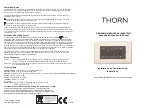
SNMP v1 and v2
The
agent maintains a list of variables, which are used to manage the device. The variables are
defined in the
MIB (Management Information Base)
. The MIB presents the variables controlled by the
agent. The SNMP agent defines the MIB specification format, as well as the format used to access the
information over the network. Access rights to the SNMP agent are controlled by access strings.
SNMPv3
v3 also applies access control and a new traps mechanism to SNMPv1 and SNMPv2 PDUs. In
USM (User-based Security Model)
is defined for SNMPv3 and includes:
•
Authentication: Provides data integrity and data origin authentication.
•
Privacy: Protects against disclosure of message content. Cipher-Bock-Chaining (CBC) is used for
encryption. Either authentication is enabled on an SNMP message, or both authentication and
privacy are enabled on an SNMP message. However privacy cannot be enabled without
authentication.
•
Timeliness: Protects against message delay or message redundancy. The SNMP agent compares
incoming message to the message time information.
•
Key Management: Defines key generation, key updates, and key use.
The device supports SNMP notification filters based on Object IDs (OID). OIDs are used by the system to
manage device features. SNMP v3 supports the following features:
•
Security
•
Feature Access Control
•
Traps
Authentication or Privacy Keys are modified in the SNMPv3 USM.
Use the SNMP page to define SNMP parameters. To display the SNMP page, click
System
>
Advanced
Configuration
>
SNMP
in the navigation menu.
SNMP Community Configuration
Access rights are managed by defining communities on the SNMPv1, 2 Community page. When the
community names are changed, access rights are also changed.
Communities are defined only
for SNMP v1 and SNMP v2.
Use the SNMP Community Configuration page to enable SNMP and Authentication notifications.
To display this page, click
System
>
Advanced Configuration
>
SNMP
>
Community
in the navigation
menu.
Use the buttons to perform the following tasks:
•
To add a community, click
Add
and configure the desired settings.
•
To change information for an existing community, select the checkbox for the entry and click
Edit
.
•
To delete a configured community from the list, select the checkbox for each entry to delete and
click
Remove
.
Configuring System Information
ExtremeSwitching 200 Series: Administration Guide
141
















































